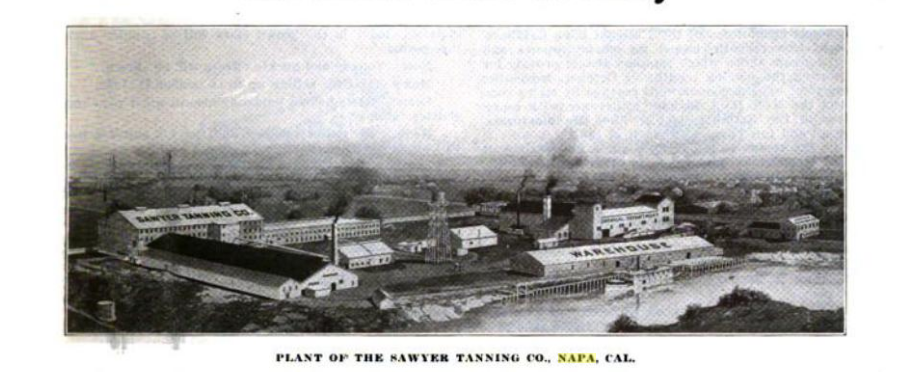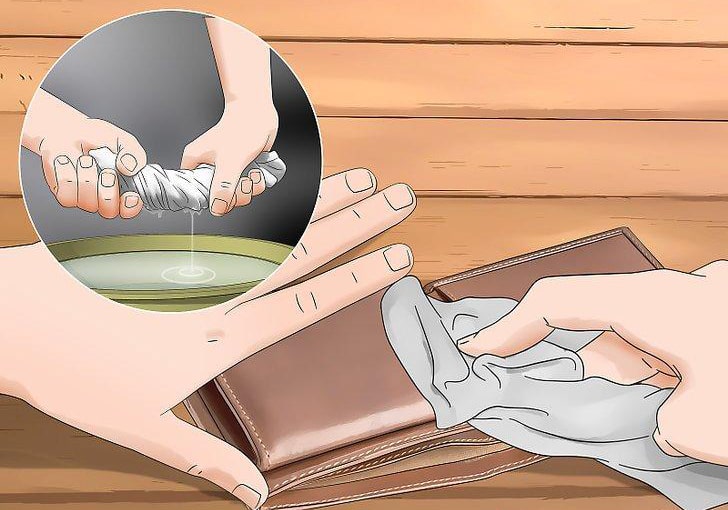Nappa leather is a broad and somewhat ambiguous term referring to soft, smooth, often full grain leather made from animal hide. Full-grain indicates that the leather in question still has its textured surface or that the surface is unaltered. As a result, Nappa leather often retains much of its original texture and look and generally feels soft and luxurious. Nappa leather is usually dyed for aesthetic reasons.
In most cases, Nappa leather is dyed to enhance aesthetic appeal.
The soft feel and the durable aspects of Nappa leather make it ideal for lining the seats in most cars, clothing, fashion accessories, and furniture.
A Brief History of Nappa Leather

NAPA LEATHERS 1869 SAWYER TANNING CO
Did you know that the term Nappa Leather was first coined by an employee named Emanuel Manasse in 1875 after the place of its origin? The employee discovered Nappa leather while working in Sawyer Tanning Company based in Napa, California.
During the early days when Nappa leather was discovered, it was processed in a specific way. The manufacturer of the Nappa leather specifically used alum salts and vegetable tanning agents to transform leather into a smooth and soft product without losing its texture. The soft, smooth, and durable qualities of Nappa leather made it ideal for making gloves. To make it more appealing, different types of dye were used on Nappa leather to enhance its aesthetic value.
The most interesting thing about the process of tanning Nappa leather is that it has not changed significantly since its discovery. Currently, aluminum and chromium sulfate are some of the salts used in the process of tanning Nappa leather. Another striking feature in the tanning process is that water-soluble colorants is used to dye Nappa leather. This process is critical as it allows Nappa leather to retain its vibrant color for many years to come even when exposed to sunlight or other elements of weather. Even wear and tear often have any significant effect on the entrenched soluble colorant on Nappa leather.
Ambiguity often surrounds the advertising of Nappa leather. This is because Nappa leather can either be referred to as corrected grain or natural grain leather. When the term natural grain is used it implies to full-grain. Besides, the two terms, full-grain or natural grain refers to Nappa leather that has intact or a surface that is unaltered.
On the contrary, corrected grain refers to a hide that has its surface buffed or removed. This is the exact opposite of natural grain leather. Why do manufacturers remove the surface of hides? Well, manufacturers remove the surface of hides so as to boost the aesthetic appeal of the end product.
A brief background check on leather grades shades more light on the underlying reason why manufacturers remove the surface of hides.
What is the nappa leather made of?
Have you ever wondered where does the soft and smooth Nappa leather come from? Nappa leather mostly comes from the hides from cows. However, it may also come from:
- Goat
- Calf
- Lamb
Ultra-premium products, be it bags, watch bands, or wallets needs to be made from a high quality hide. But what determines the quality of a hide? An animal that is treated in a humanly manner and eat well produces high quality hides that has few blemishes.
There is no standardized definition for each grade of leather
Full Grain
If you come across a high quality and unblemished hides then they are mostly to be tanned into Natural Grain or Full Grain leather. Does it mean that all full grain or natural leather are entirely unblemished? No! In fact, the inherent superiority and overall quality of a hide can overshadow the blemishes and streaks of a hide. This has been the point of sale of an artisanal movement that has been prizing its full grain leather that has some blemishes. The high-quality of full grain leather as well as being difficult to work with as compared to other form of leather makes the product made from full grain quite expensive.
The full grain hide is regarded as being of high quality because of a number of reasons. First, natural grain hide consist of the top part of a hide characterized by the entire animal’s grain. Secondly, full grain hide are durable because it has densely packed fibers. The third and the last aspect is that natural grain leather is supple and extremely soft feel to touch despite the fact that it has densely packed grains, an aspect that makes it durable. As a result, full grain leather is a high-end luxurious products.
Top grain
Most consumers would think that the top grain leather refers to the unaltered leather. Unfortunately, this is not so. The difference between top grain and full grain leather is that top grain leather has the outermost layer removed. The removal of the outermost layer is done through buffing or sanding. This process helps to conceal blemishes or any other imperfections. However, in order to restore the visually appealing appearance of a full grain, the leather is artificially embossed.
How do you differentiate the top grain and full grain leather? A careful examination of the types of leather reveals a striking difference. The first difference is that top grain leather has a decreased level of softness as compared to full grain leather. Secondly, top grain leather is comparatively pliable since it is thinner as compared to full grain leather. Despite the fact that sanding changes both the texture as well as the grains of top leather, the natural durability is not altered in any way.
Is corrected grain synonymous with top grain? The alteration of full grain leather either by sanding or buffing will automatically yield Corrected Grain leather.
It is worth noting that some corrected grain leather still has a large percentage of full grain. However, in this case, the manufacturers have sanded away areas that has blemishes or has unsightly scars. With this in mind, it always good to remember that a buffed or sanded full grain leather makes a corrected grain.
How to Clean Nappa Leather
The easiest way to enhance the durability and appeal of Nappa leather by taking good care of the leather. What do you need when you need to clean Nappa leather? Cleaning Nappa leather is easy and you only need few supplies that include a cotton washcloth, lint-free cloth, lukewarm water, and mild dish soap, and finally a leather protectant. Also, purchasing leather conditioner and a stain protector may also help to enhance the overall process of cleaning Nappa leather. In order to clean Nappa leather, you need to follow the following steps:
- Remove debris and dirt using a lint-free cloth
- Use warm water to remove stains, cotton washcloth, and mild dish soap
- Do not rub stains but rather dab at the stains
- Let the leather dry thereafter
- Apply leather conditioner and leather protectant

